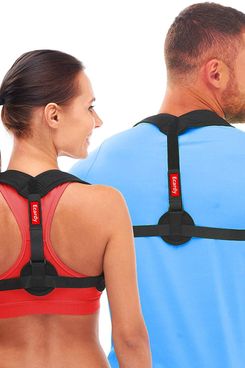
As a freelance writer, I’ve had my fair share of lows. The many (many) times I never heard back about pitches, of course, or when the cashier at my bodega told me he liked my “ecofriendly” wardrobe after I showed up in the same outfit for the third day in a row. One of my lowest lows came almost a year ago, after a free — but definitely not complimentary — session with a trainer at a gym I’d joined. According to him, my cute mid-century desk chair at home was not meeting my ergonomic needs, and slumping had ravaged my posture, softened my core, and left me woefully misaligned. His prognosis: “I’ve never seen anything like this!”
Apparently, I was on the verge of becoming the Quasimodo of Park Slope. But instead of investing my paltry freelance income into more verbal abuse from the trainer, I headed to Amazon, to find a more supportive (literally) option for rehabilitating my back. After cruising through reviews for various over-the-counter posture correctors, I narrowed my search to braces with armpit pads (underarm abrasion was a common complaint), landing on one from Andego, whose description featured an illustrated “progress chart” showing a man in improving states of slump on his journey to standing tall (the brand promises that, after 14 days of regular wear, you can “keep your back upright even without the corrector”). In the last picture, he is flashing a victorious thumbs-up. That could be me, I thought as I clicked buy.
The brace is essentially an over-the-shoulders harness that you wiggle into, as you might a trusty cardigan. You adjust it by pulling on two dangling straps, like a backpack; when you pull them tight, your shoulders immediately cinch back. I found it a little uncomfortable to wear at first, but never painful (there are included Velcro armpit pads you can attach to the shoulder straps to minimize chafing). The instructions say to wear it for 30 to 40 minutes a day for the first week, and then add 20 minutes a day until you can wear it all day — which seems excessive, even now that I’ve acclimated to it. In it, my arms are a little less flexible; I can’t quite stretch all the way across my bed to tuck sheets in, but I can do chores like wash dishes. Due to its design, the brace doesn’t really support my lower back, so I can still slump a bit while wearing it at my desk (though just knowing that I’m in it seems to help prop me up straighter).
After wearing it every day for two weeks, I actually began to see results like the progress chart promised. Granted, I’d also taken up going to the gym more (hiding behind ellipticals when I spotted the trainer), so some of my newfound core strength was surely thanks to working out. Still, within a month, I noticed more mobility in my shoulder region, and that I could hold my shoulders back naturally without the brace on. Thumbs-up!
Months later, I’m still wearing the brace, and it still feels a bit uncomfortable — but in a good way, like being pressed into a deep stretch when your muscles are tense. To be sure the thing is as corrective as it seems, and that continued wear would not reverse my apparent progress, I called up Jason DiTullio, a chiropractor at Alignment NYC. He told me that braces like mine are usually a great supplement to working out, so my gym-going made me “an ideal candidate for success.” Slumping — whether you’re sitting or standing — can misalign certain areas of the back, he explained, and the brace helps activate muscles that aren’t engaged by imperfect posture. “You’re retraining the body and the musculature of your back.” He also said the brace should be slightly uncomfortable, even after months of wear — but never painful — and noted that anyone who has had surgery or has a history of spinal issues should see a chiropractor before slipping into one, “just because we’re experts.”
More Strategist-approved posture correctors
Writer Maureen O’Connor, who also works from home, uses this attachable support to better align her back while sitting down at her desk. “Before Easy Posture, I spent the seated portion of my day hunched in a ball,” she told us. “But like a classic before-and-after, now I’m standing taller and feeling great.”
Trainer Christina Nassaney told us about this “wearable postural alignment tool that gives tactile feedback” via a small sensor worn on the back that’s linked to an app, which will alert you when you’re slouching. Chiropractor David Perna is also a fan.
The Strategist is designed to surface the most useful, expert recommendations for things to buy across the vast e-commerce landscape. Some of our latest conquests include the best acne treatments, rolling luggage, pillows for side sleepers, natural anxiety remedies, and bath towels. We update links when possible, but note that deals can expire and all prices are subject to change.








